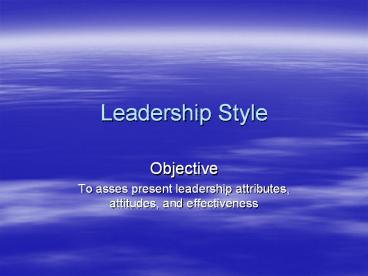Leadership%20Style - PowerPoint PPT Presentation
Title:
Leadership%20Style
Description:
What does leadership mean to you? Using influence in an ... Leadership is the ability to persuade others to seek defined objectives enthusiastically. ... – PowerPoint PPT presentation
Number of Views:53
Avg rating:3.0/5.0
Title: Leadership%20Style
1
Leadership Style
- Objective
- To asses present leadership attributes,
attitudes, and effectiveness
2
Leadership
- What does leadership mean to you?
- Using influence in an organizational setting or
situation, producing effects that are meaningful
and have a direct impact on accomplishing
challenging goals. - Enthusiastically and Competently
- A behavioral process
3
Leaders Managers
- Leadership is a part of management but not all of
it Leadership is the ability to persuade others
to seek defined objectives enthusiastically. It
is the human factor which binds a group together
and motivates it toward goals. Management
activities such as planning, organizing, and
decision making are dormant cocoons until the
leader triggers the power of motivation in
people and guides them toward goals (Davis, 1967).
4
Trait Theory
- An attempt to identify specific characteristics
(physical, mental, personality) associated with
leadership success. The theory relies on research
that relates various traits to certain success
criteria. - LEADERS ARE BORN
- What about situations?
5
Traits Associated with Leadership Effectiveness
- Intelligence Personality Abilities
- Judgment Adaptability Ability to enlist
cooperation - Decisiveness Alertness Cooperativeness
- Knowledge Creativity
- Fluency of speech Personal integrity Sociability
- Emotional balance Tact, diplomacy
- and Control
- Popularity prestige
- Independence
- Self-confidence Social participation
6
Behavioral Approaches
- In the late 1940s, researchers began to explore
the notion that how a person acts determines that
persons leadership effectiveness. Instead of
searching for traits, these researchers examined
leader behaviors and their impact on the
performance and satisfaction of followers.
7
Why Trait and Behavior Approaches Fall Short
Trait approaches consider personal
characteristics of the leader that may be
important in achieving success in a leadership
role.
A shortcoming of both of these approaches is that
they fail to take into account the interaction
between people, tasks, and environment.
Behavioral approaches attempt to specify which
kinds of leader behaviors are necessary for
effective leadership.
8
Situational Leadership
- An approach to leadership advocating the leaders
understand their own behavior, the behavior of
their subordinates, and the situation before
utilizing a particular leadership style. - This approach requires diagnostic skills in human
behavior on the part of the leader.
9
Fiedlers Contingency Modelof Leadership
Effectiveness
- Description of the Model
- Leadership effectiveness is contingent upon the
fit between the leaders style and the situational
favorableness. - Leaders can have high employee or task
orientations - Leadership style is measured by the
Least-Preferred Coworker Scale (LPC). - Situation favorableness determined by 1)
leader-member relations 2) task structure 3)
position power - Exhibit 10.4 Chella book
10
Hersey-Blanchard Situational Leadership Model
- Description of the Model
- A situational leadership theory that emphasizes
followers and their level of maturity. The
leader must properly judge or intuitively know
followers maturity level and then use a
leadership style that fits the level. - The Four Leadership Styles
- Telling - the leader defines the roles needed to
do the job and tells followers what, where, how,
and when to do the tasks.
11
Hersey-Blanchard Situational Leadership Model
- Description of the Model
- The four leadership styles (continued)
- Selling - the leader provides followers with
structured instructions, but is also supportive. - Participating - the leader and followers share in
decisions about how best to complete a
high-quality job. - Delegating - the leader provides little specific,
close direction or personal support to followers.
12
Hersey-Blanchard Situational Leadership Model
- Description of the Model
- Level of subordinate
- DI high enthusiasm but low knowledge
- DII low enthusiasm and low knowledge
- DIII knowledge and enthusiasm improving
- DIV high knowledge and high enthusiasm
- You must match your leadership style with their
level to succeed as a coach/manager and move them
up the ladder
13
Transformational Leadership
- Transformational leadership
- Influencing major changes
- Discontent with the status quo
- Builds commitment
- Creates new vision empowers members
- Weeses 5 C Model
- Credible character
- Compelling vision
- Charismatic communicator
- Contagious enthusiasm
- Culture builder
14
Transformational Leadership
- Composed of
- Charismatic leadership
- Intellectual stimulation
- Individualized consideration
15
Exhibit 12.5 Stages of Charismatic Leadership
Stage One - Detecting unexploited opportunities
and deficiencies in the present situation -
Sensitivity to constituents needs -
Formulating an idealized strategic vision
Stage Two - Communicating the vision -
Articulating the status quo as unacceptable
and the vision as the most attractive
alternative - Articulating motivation to lead
followers
Stage Three - Building trust through technical
expertise, personal risk-taking, self-
sacrifice, and unconventional behavior
Stage Four - Demonstrating the means to
achieve the vision through role modeling,
empowerment, unconventional tactics































